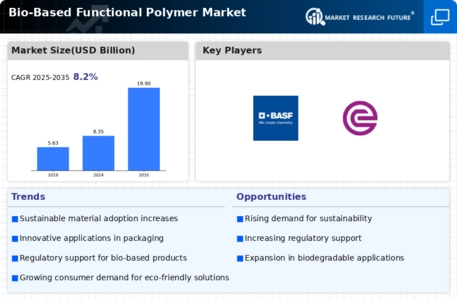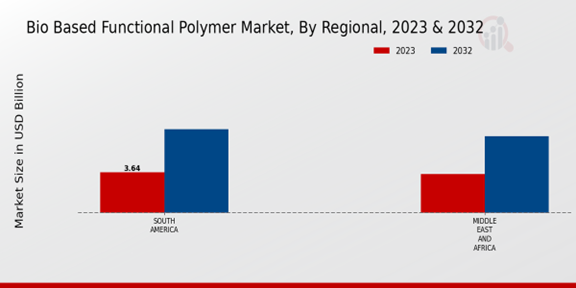Market Growth Projections
The Global Bio-Based Functional Polymer Market Industry is projected to experience robust growth, with significant market metrics indicating a promising future. The market is expected to reach 8.35 USD Billion in 2024, with an anticipated CAGR of 8.21% from 2025 to 2035. This growth trajectory suggests a strong shift towards bio-based materials across various industries, driven by sustainability trends and technological advancements. The increasing adoption of bio-based polymers in packaging, automotive, and consumer goods is likely to further bolster market expansion, reflecting a broader commitment to environmental stewardship and innovation.
Rising Consumer Awareness
Rising consumer awareness regarding environmental issues is significantly influencing the Global Bio-Based Functional Polymer Market Industry. As consumers become more informed about the detrimental effects of conventional plastics, there is an increasing demand for sustainable alternatives. This trend is evident in the packaging industry, where brands are actively seeking bio-based materials to meet consumer expectations for eco-friendly products. Companies that adopt bio-based polymers often report enhanced brand loyalty and market differentiation. This growing consumer preference is expected to propel the market, contributing to its projected growth to 19.9 USD Billion by 2035.
Sustainability Initiatives
The Global Bio-Based Functional Polymer Market Industry is witnessing a surge in demand driven by sustainability initiatives. Governments worldwide are increasingly promoting the use of bio-based materials to reduce reliance on fossil fuels and minimize environmental impact. For instance, various countries have implemented regulations and incentives to encourage the adoption of bio-based polymers in packaging, automotive, and construction sectors. This shift is likely to enhance market growth, as consumers and industries alike prioritize eco-friendly alternatives. The market is projected to reach 8.35 USD Billion in 2024, reflecting a growing commitment to sustainable practices across multiple sectors.
Technological Advancements
Technological advancements play a pivotal role in the expansion of the Global Bio-Based Functional Polymer Market Industry. Innovations in polymerization techniques and material processing are enhancing the performance and applicability of bio-based polymers. For example, breakthroughs in biopolymer synthesis have led to the development of high-performance materials suitable for demanding applications, such as automotive components and medical devices. These advancements not only improve product functionality but also contribute to cost-effectiveness, making bio-based polymers more competitive against traditional petroleum-based options. As a result, the market is anticipated to grow significantly, with a projected CAGR of 8.21% from 2025 to 2035.
Expanding Application Areas
The expanding application areas of bio-based polymers are significantly contributing to the growth of the Global Bio-Based Functional Polymer Market Industry. Bio-based functional polymers are increasingly being utilized in diverse sectors, including packaging, automotive, textiles, and healthcare. For instance, in the automotive industry, bio-based composites are being used to manufacture lightweight components that enhance fuel efficiency. This diversification of applications not only broadens the market scope but also attracts investments from various industries seeking sustainable solutions. Consequently, the market is poised for substantial growth, with projections indicating a rise to 19.9 USD Billion by 2035.
Government Policies and Regulations
Government policies and regulations are crucial drivers of the Global Bio-Based Functional Polymer Market Industry. Many governments are enacting stringent regulations aimed at reducing plastic waste and promoting the use of renewable materials. For instance, the European Union has introduced directives to phase out single-use plastics, thereby creating a favorable environment for bio-based alternatives. These regulatory frameworks not only encourage manufacturers to invest in bio-based polymer production but also stimulate innovation in the sector. As a result, the market is likely to experience robust growth, supported by favorable policy landscapes across various regions.














Leave a Comment